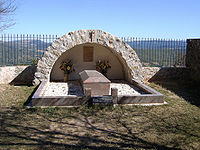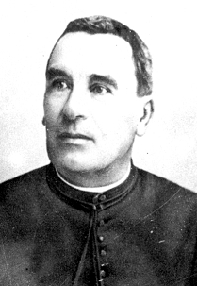Bérenger Saunière


Bérenger Saunière (born April 11, 1852 in Montazels , † January 22, 1917 in Rennes-le-Château ) was a French pastor in Rennes-le-Château, who was speculatively associated with the Prieuré de Sion .
Life
Bérenger Saunière was the eldest son of Marguerite and Joseph Saunière, three more sons and three daughters were born after him. The father was mayor of Montazels, head of a mill and administrator of the castle of the Marquis de Cazermajou and then of Monsieur de Bourzès. Brother Alfred became a priest, Brother Joseph died at 25 while studying medicine. Bérenger spent his school years at St. Louis School in Limoux .
In 1874 Saunière entered the seminary of Carcassonne . He was ordained a priest three years later and began serving as vicar in Alet-les-Bains . In 1882 he was transferred to La Clat and appointed professor at the Narbonne seminary . Due to disciplinary incidents, however, Saunière was transferred to Rennes-le-Château, where he took over the parish on June 1, 1885.
Saunière was openly anti-republican and was therefore forced by the prefecture to leave his community from December 1885 to July 1886, after which he taught at the seminary again. However, under pressure from the city administration, the prefect revoked his decision. In 1890, Saunière was assigned to Antugnac as a parish in addition to the very small Rennes-le-Château .
Saunière advertised in many religious magazines (including Semaine Religieuse, La Croix, L'éclair, L'Express du Midi) in order to receive scholarships . He then received numerous letters with money orders - from his notes it can be deduced that between 1896 and 1915 he received payments for at least a hundred thousand masses, of which he could only read a few hundred annually. With this income he became a wealthy man.
Saunière renovated the small village church of Sainte Marie-Madeleine and redesigned it together with Henri Boudet . In 1902 the pastor got a glass eye. He lived with the Dénarnaud family in the rectory; however, he got along very poorly with Marie Dénarnaud's mother. He therefore preferred to stay in the building he had built next to the cemetery. A year later there was a dispute between Saunière and Boudet, who had accused his friend of "an unseemly way of life for a priest".
During a visitation , the new Bishop of Carcassonne, Monseigneur Paul-Félix Beuvain de Beauséjour , demanded an account of the origin and use of Saunière's funds. The pastor tried to prevent an invoice from being disclosed by reporting sick several times. Several defense attempts followed, with Saunière alleged to have declared, among other things, that he had found treasure, which the bishop saw through. Saunière finally declared that everything belonged to his housekeeper Marie Dénarnaud.
In 1911 Saunière was relieved of his office ("suspensus a divinis"). But he stayed in Rennes-le-Château. His successor Abbé Marty was unsuccessful: the residents of Rennes-le-Château, whom Saunière had taken care of financially years earlier, had not forgotten this and came to Saunière's fairs in the winter garden of his Villa Béthania . However, there was no cash flow. The pastor had to sell a lot of his private property.
Saunière appealed to Rome and was reinstated as pastor of Rennes-le-Château after performing a penitential pilgrimage to Lourdes .
Later embellishments
Noël Corbu (1912–1968) a former crime novelist, owner of the Saunière property in 1953, was the first to tell of its fabulous wealth and to invent an embellished story of an allegedly found treasure.
In the early 1960s, Corbu met Pierre Plantard , who adapted the Sauniérel legend for his own purposes and established a relationship with the Prieuré de Sion . According to his version, Saunière's treasure consisted primarily of documents that showed Plantard to be the actual heir of the Merovingians . Saunière discovered these documents, which Abbé Bigou had hidden in the wooden altar pillar a century earlier, during restoration work.
The stories became the basis of the multiple published book The Holy Grail and its heirs by the authors Lincoln / Baigent / Leigh, who made the Holy Grail out of the treasure . The writer Dan Brown continued the story in his novel The Da Vinci Code .
literature
- Gérard de Sède: L'Or de Rennes ou la Vie insolite de Bérenger Saunière. Curé de Rennes-le-Château . Julliard, Paris 1967; first controversial book on the subject (French).
- Claire Corbu, Antoine Captier: L'héritage de l'Abbé Saunière . Bélisane, Nice 1985, ISBN 2-902296-56-8 ; Part of the Bélisane Collection (French).
Movies
- Secret acts of sacrilege. The Myth of Rennes le Chateau , TV documentary as part of the Terra X series , ZDF ( online )
- The Pastor and the Holy Grail , television documentary as part of the series Mythenjäger , ZDF ( online )
Web links
- Literature by and about Bérenger Saunière in the catalog of the German National Library
- Rob Kieffer: The secret of Abbe Sauniere , in: FAZ , May 30, 2006.
| personal data | |
|---|---|
| SURNAME | Saunière, Bérenger |
| BRIEF DESCRIPTION | French Catholic pastor |
| DATE OF BIRTH | April 11, 1852 |
| PLACE OF BIRTH | Montazels , France |
| DATE OF DEATH | January 22, 1917 |
| Place of death | Rennes-le-Château , France |


